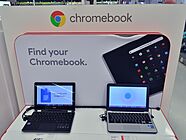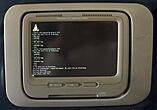Linux facts for kids
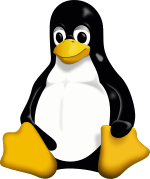
Tux the penguin, the mascot of Linux
|
|
| Company / developer | Community contributors, Linus Torvalds |
|---|---|
| Programmed in | C, assembly languages, Rust and others |
| OS family | Unix-like |
| Working state | Current |
| Source model | Open source |
| Initial release | August 25, 1991 |
| Marketing target | Cloud computing, embedded devices, mainframe computers, mobile devices, personal computers, servers, supercomputers |
| Available language(s) | Multilingual |
| Supported platforms | Alpha, ARC, ARM, C-Sky, Hexagon, LoongArch, m68k, Microblaze, MIPS, Nios II, OpenRISC, PA-RISC, PowerPC, RISC-V, s390, SuperH, SPARC, x86, Xtensa |
| Kernel type | Monolithic |
| Userland | util-linux by standard, various alternatives, such as Busybox, GNU, Plan 9 from User Space and Toybox |
| Influenced by | Minix, Unix |
| Default user interface |
|
| License | GPLv2 |
Linux (pronounced LIN-uuks) is a group of open-source operating systems. These systems are like Unix and are built around the Linux kernel. The Linux kernel is the main part of the operating system. It was first released on September 17, 1991, by Linus Torvalds.
Linux is usually put together as a "distribution" (or "distro"). A distro includes the Linux kernel and other important software. This software helps the system work completely. Many parts of Linux are based on Unix and are released under a special license called GPL.
There are thousands of Linux distributions. Some popular ones are Debian, Fedora Linux, Linux Mint, Arch Linux, and Ubuntu. Companies also make their own versions, like Red Hat Enterprise Linux and ChromeOS. Linux is often used for servers. The Free Software Foundation suggests calling it "GNU/Linux" because many distributions use software from the GNU Project.
Linux is a great example of how people can work together on free and open-source software. It was first made for x86 personal computers. But now, it runs on more types of devices than any other operating system. You can find Linux on PCs, workstations, mainframe computers, and embedded systems. Linux is the main operating system for servers. It also runs on all of the world's 500 fastest supercomputers. When you add Android (which uses the Linux kernel) for smartphones, Linux-based systems are the most used operating systems overall.
Contents
What is Linux?
The Linux kernel was created by Linus Torvalds. He started it because the GNU Project needed a working kernel. GNU was making a Unix-like operating system using only free software. A system called Minix was available, but its license wasn't fully free for everyone.
The first completely free Unix for personal computers, 386BSD, came out in 1992. By then, Torvalds had already released the first Linux kernel online. Linux, like GNU and 386BSD, was built from scratch. This helped it avoid legal problems that other Unix systems faced. Linux distributions became popular in the 1990s. They made Unix technology available to people at home on their personal computers. Before this, Unix was mostly used on powerful workstations.
How Linux Looks and Works
Desktop Linux distributions come with a windowing system like X11 or Wayland. They also have a desktop environment such as GNOME, KDE Plasma, or Xfce. These make it easy to use your computer with a mouse and keyboard. Linux versions for servers might not have a graphical interface at all. They might just use text commands.
The source code for Linux can be used, changed, and shared by anyone. This can be for free or for money. This is allowed under licenses like the GNU General Public License (GPL). This license makes it easy for anyone to create new Linux distributions. This is different from operating systems like MacOS or Microsoft Windows. The Linux kernel itself is under the GPLv2 license.
Where Linux is Used Today
Because Android (which uses Linux) is so popular on smartphones, Linux has the most users among all operating systems as of May 2022. As of March 2024, about 4% of desktop computers use Linux. Chromebooks, which run ChromeOS (based on the Linux kernel), are very popular in US schools. They also make up almost 20% of cheaper notebook sales in the US.
Linux is the top operating system for servers. Over 96.4% of the top one million web servers use Linux. It's also used on all of the world's 500 fastest supercomputers as of November 2017.
Linux also runs on embedded systems. These are devices where the operating system is built into the device itself. Examples include routers, smart home devices, video game consoles, and televisions. It's even in cars like Tesla and in spacecraft like the Falcon 9 rocket and the Ingenuity Mars helicopter.
The Story of Linux
Early Computer Systems
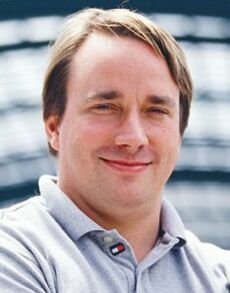
The Unix operating system was created in 1969 at AT&T's Bell Labs. It was first written in a complex assembly language. But in 1973, it was rewritten in the C programming language. This made it much easier to use Unix on different computers.
AT&T was not allowed to be in the computer business at first. So, they gave away the Unix source code to anyone who asked. This made Unix very popular in schools and businesses. In 1984, AT&T was allowed to sell Unix as its own product. This meant users could no longer legally change it.
Companies like Sun Microsystems started selling Unix-based computers in the 1980s. These were powerful machines for single users.
The Free Software Movement
Because Unix became a paid product, Richard Stallman started the GNU Project in 1983. His goal was to create a complete Unix-like system using only free software. Free software means you can use, study, change, and share it freely. By the early 1990s, many parts of GNU were ready, like tools for writing code and editing text. But the main part, the kernel, called GNU Hurd, was not finished.
Minix was created by Andrew S. Tanenbaum in 1987. It was a small Unix-like system for students to learn about operating systems. Its full source code was available, but its license limited its use until 2000.
How Linux Began
In 1990, Linus Torvalds was a student at the University of Helsinki. He took a Unix course and learned about Minix. He became very interested in operating systems. Because Minix had licensing limits, he decided to create his own kernel in 1991. This became the Linux kernel.
Torvalds started developing Linux on Minix. He used Minix applications on Linux at first. As Linux grew, more development happened directly on Linux systems. GNU programs also replaced Minix parts. This was good because GNU code was free to use. Torvalds changed his original license to the GNU GPL. This allowed developers to combine GNU parts with the Linux kernel. This created a full, free operating system.
Another free Unix-like system, 386BSD, was also being developed around this time. It was released in 1992. Linus Torvalds has said that if the GNU kernel or 386BSD had been ready in 1991, he might not have created Linux.
Naming the Project
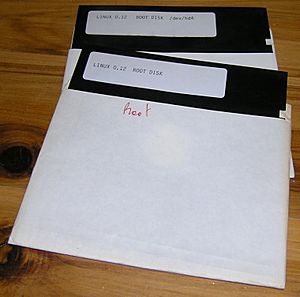
Linus Torvalds wanted to call his project "Freax." This name was a mix of "free," "freak," and "x" (like in Unix). He used this name for about six months. He thought "Linux" was too much about himself.
In September 1991, the files were uploaded to a server at FUNET to help with development. Ari Lemmke, a co-worker of Torvalds, was a volunteer administrator for the server. He didn't like the name "Freax." So, he named the project "Linux" on the server without asking Torvalds. Later, Torvalds agreed to the name.
Torvalds said that "Linux" should be pronounced LIN-uuks, with a short 'i' like in 'print' and 'u' like in 'put'. He even included an audio guide with the kernel code to show how to say it.
Linux Grows in Popularity
Linux started to be used by companies and not just hobbyists in the mid-1990s. The supercomputing community, like NASA, began using Linux. They replaced expensive machines with groups of cheaper computers running Linux. Companies like Dell and IBM then started offering Linux support. They wanted to offer an alternative to Microsoft's operating system.
Today, Linux systems are used everywhere. They are in small embedded systems and almost all supercomputers. They are also very common in server setups. Linux is also becoming more popular on home and business desktops.
Linux distributions are also popular on netbooks. Many netbooks come with special Linux versions. Google even made ChromeOS for netbooks, which is based on Linux.
Linux has been most successful in the mobile world. Android, which uses the Linux kernel, is the main operating system for smartphones. It's also popular on tablets and wearables. Linux gaming is also growing. Valve supports Linux and created SteamOS, a Linux version for gaming. This is used on their Steam Deck platform. Governments in places like Brazil and China also use Linux.
How Linux is Built
Many developers of open-source software believe that the Linux kernel wasn't designed in a strict way. Instead, it "evolved" over time. Linus Torvalds said that Unix was a starting point. But Linux grew with many changes, like "mutations." These changes were faster and more focused than random changes.
Linux is a modular operating system, meaning it's built from many parts. It's like Unix in its basic design. It uses a monolithic kernel, the Linux kernel. This kernel manages how programs run, how the network works, and how the computer accesses its parts. Device drivers, which help the computer talk to hardware, are either built into the kernel or added as modules.
The GNU "userland" is a key part of most Linux systems. This is the software that users interact with. The GNU C library helps programs talk to the Linux kernel. The GNU toolchain includes important tools for building Linux software. The coreutils provide basic Unix tools. Bash is a popular command-line tool. The graphical user interface (GUI) on most Linux systems is built on the X Window System. Some parts of the Linux community are now moving to Wayland as a newer way to handle graphics.
Many other open-source projects also help build Linux systems.
Parts of a Linux System
A Linux system includes these main parts:
- A bootloader, like GNU GRUB. This program loads the Linux kernel when you turn on the computer.
- An init program, like systemd. This is the first program the Linux kernel starts. It launches other programs like system services and login screens.
- Software libraries. These contain code that programs can use. The GNU C Library (glibc) is a common one. For smaller devices, there are other options like musl.
- Basic Unix commands. GNU coreutils is the standard set. For small systems, BusyBox or Toybox are used.
- Widget toolkits. These are libraries used to build graphical interfaces for applications. Examples include GTK and Qt.
- A package management system, like apt or RPM. These help you install, remove, and update software easily.
- User interface programs, like command shells or windowing environments.
How You Interact with Linux
The user interface (or "shell") can be text-based (CLI) or graphical (GUI). For desktop computers, the GUI is usually the default. But you can still use text commands in a terminal emulator window.
CLI shells use text for both input and output. The most common one in Linux is Bash. Many low-level Linux parts use the CLI. It's great for automating tasks and for programs to talk to each other.
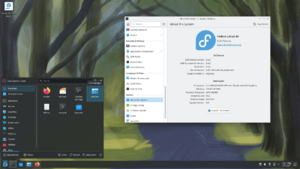
On desktop systems, the most popular interfaces are GUI shells. These come with full desktop environments like KDE Plasma, GNOME, MATE, Cinnamon, and Xfce. Most popular GUIs are built on the X Window System, often called "X" or "X11." X11 lets graphical programs running on one computer be shown on another.
There are different types of window managers for X11. These control how application windows look and are placed. Simple window managers like i3wm offer basic functions. More complex ones like Enlightenment have more features like a built-in taskbar. Desktop environments include their own window managers, but users can often choose a different one.
Wayland is a newer display server that aims to replace X11. As of 2022, it's becoming widely used. Wayland doesn't need a separate window manager. Instead, a "Wayland compositor" handles everything.
Developing for Linux
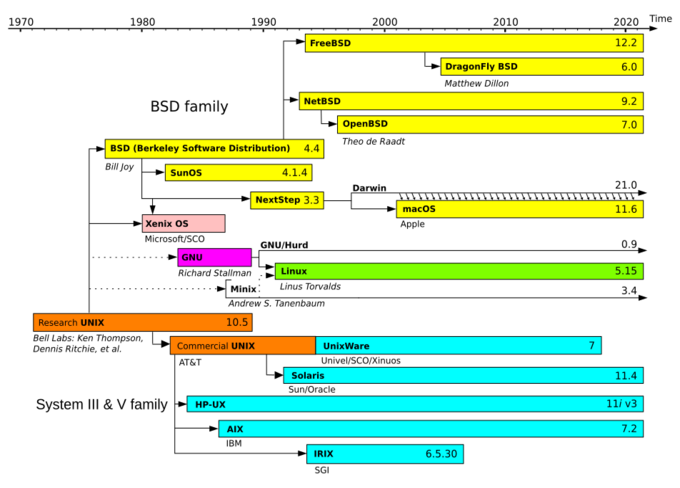
The main difference between Linux and many other operating systems is that Linux is free and open-source software. This means its code is available for anyone to use, change, and share. Linux is not the only open-source operating system, but it's the most widely used. Some open-source licenses use "copyleft." This means any software made from copyleft code must also be copyleft. The GNU General Public License (GPL) is a type of copyleft license. It's used for the Linux kernel and many GNU Project parts.
Linux systems are designed to work well with other operating systems and computer standards. They follow standards like POSIX and ISO. This helps ensure compatibility.
Free software projects are often developed by different groups working independently. But because their licenses allow sharing, larger projects can collect this software. They then make it available as a Linux distribution.
Many Linux distributions offer a way to download and install software packages over the internet. This lets users customize their operating system. Distributions are maintained by people, teams, volunteer groups, and companies. They handle the basic setup of Linux, security, and making sure all the software works together. They often use a "package manager" like apt or pacman to manage software.
The Linux Community
The Linux community is made up of developers and users. Some groups, like Debian, are run by volunteers. Others, like Red Hat with Fedora, have community versions of their commercial products.
In many places, there are Linux User Groups (LUGs). These groups promote Linux and free software. They hold meetings, offer training, and help new users install Linux. Many online communities also support Linux users. Most distributions have chat rooms or online forums. Examples include LinuxQuestions.org and forums for Ubuntu or Fedora.
There are also many websites and magazines focused on Linux.
Even though Linux distributions are usually free, many large companies support and help develop Linux. A 2017 study of the Linux kernel showed that over 85% of the code was written by paid programmers. Companies like Intel, Samsung, and Google contribute a lot. Some companies, like Red Hat and Canonical, have built big businesses around Linux.
The free software licenses encourage businesses to use Linux. Companies often make money by charging for support, especially for businesses. Some offer special business versions of their distributions. Another way companies make money is by giving away the software and selling hardware that runs it.
Programming on Linux
Most programming languages work on Linux. The main tools for building Linux programs are in the GNU toolchain. This includes the GNU Compiler Collection (GCC), which compiles code for languages like C and C++. Many languages like PHP, Perl, Python, and Java have versions that run on Linux. The LLVM project also provides another open-source compiler.
Linux also includes special programming languages for scripting and managing the system. These include shell scripts, awk, and sed. Many programs also have their own built-in languages for customization.
Most Linux distributions support dynamic languages like PHP, Perl, and Python. There are also many Integrated development environments (IDEs) available for Linux, like Eclipse and NetBeans. Popular text editors like Vim and Emacs are also widely used.
Hardware Support
The Linux kernel can run on a huge variety of devices. These range from mobile phones to supercomputers. It works on many different computer architectures, including ARM-based Android phones and IBM Z mainframes. There are special Linux versions for less common hardware. For example, the ELKS kernel can run on older 16-bit microprocessors.
Linux is known for supporting older hardware very well. It keeps standard drivers for a long time. There are groups and conferences that work to improve hardware support for Linux. Over time, Linux has gotten much better at working with different hardware. This means new hardware usually has a "good chance" of being compatible.
How Many People Use Linux?
Many studies look at how much free and open-source software is used. The Linux market is growing. It's expected to reach $15.64 billion by 2027, up from $3.89 billion in 2019. Experts think it will grow to $34.90 billion by 2032. People say Linux is successful because it's secure, reliable, low-cost, and avoids being locked into one company's products.
Desktops and Laptops
As of October 2024, about 4.3% of desktop computers use Linux. In comparison, Microsoft Windows has about 73.4% of the market, and macOS has about 15.5%.
Web Servers
Studies show that Linux is very popular for web servers. As of May 2015, W3Cook estimated that 96.55% of web servers use Linux. W3Techs, as of November 2020, estimated that Linux is used by 39% of web servers. Other estimates say it's as high as 55%.
As of 2024, Linux is thought to power at least 80% of public cloud services. This is because it's widely used on platforms like Amazon Web Services (AWS) and Google Cloud Platform.
Mobile Devices
Android, which uses the Linux kernel, is the most popular operating system for smartphones. In April 2023, 68.61% of mobile devices visiting websites used Android. Android is also popular for tablets, making up over 60% of sales in 2013. As of October 2021, Android has about 71% of the mobile market share.
Film Production
Linux has been the top choice in the film industry for many years. The first major film made using Linux servers was Titanic in 1997. Since then, big studios like DreamWorks Animation and Pixar have switched to Linux. The Linux Movies Group says that over 95% of servers and desktops at large animation and visual effects companies use Linux.
Government Use
Linux distributions are also popular with governments. The Russian military has created its own Linux distribution. The Indian state of Kerala requires all high schools to use Linux on their computers. China uses Linux for its Loongson processors to be independent in technology. In Spain, some regions have made their own Linux distributions for schools and government. France and Germany have also started using Linux more. North Korea's Red Star OS is based on Fedora Linux.
Copyright and Naming
The Linux kernel is licensed under the GNU General Public License (GPL), version 2. This license means that anyone who shares software based on this code must also make the original code (and any changes) available to others under the same rules. Other key parts of Linux distributions are also mostly under the GPL. Some libraries use the GNU Lesser General Public License (LGPL), which is a bit more flexible.
Linus Torvalds has said that the Linux kernel will not switch from GPL version 2 to version 3. He doesn't like some parts of the new license that stop software from being used with digital rights management. Also, it would be very hard to get permission from all the thousands of copyright holders.
A study in 2001 looked at Red Hat Linux 7.1. It found that this distribution had 30 million lines of code. The study estimated that it would have taken about eight thousand person-years of work to develop. If this software had been made by traditional companies, it would have cost about $1.08 billion in 2000. Most of the code (71%) was written in the C programming language.
A later study on Debian version 4.0 (released in 2007) found it had almost 283 million lines of code. It was estimated to have cost about $7.17 billion in 2007 to develop using traditional methods.
In the United States, the name Linux is a trademark owned by Linus Torvalds. At first, no one registered it. But in 1994, someone else tried to claim the trademark and demand money from Linux distributors. In 1996, Torvalds sued to get the trademark back, and he won in 1997. The Linux Mark Institute (LMI) now handles the trademark. Torvalds said he trademarked the name only to stop others from using it unfairly. LMI used to charge a small fee to use the Linux name, but now it offers a free, worldwide license.
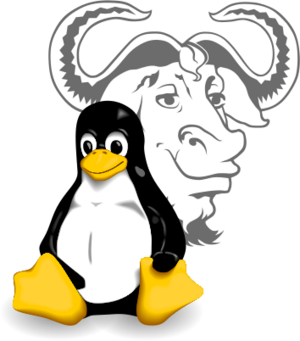
The Free Software Foundation (FSF) prefers the name GNU/Linux for the whole operating system. They see Linux distributions as versions of the GNU operating system, which Richard Stallman started in 1983. The FSF doesn't have a problem with the name Android, even though it also uses the Linux kernel, because GNU software isn't part of Android.
Some people and projects, like Debian (which the FSF supported until 1996), also use GNU/Linux. However, most media and common use simply call these operating systems Linux. Many large Linux distributions, like SUSE Linux and Red Hat Enterprise Linux, also use just "Linux" in their names.
As of May 2011, about 8% to 13% of the code in the Ubuntu Linux distribution was from GNU components. The Linux kernel itself made up about 6% of the code.
More to Explore
- Comparison of Linux distributions
- Comparison of operating systems
- Linux kernel version history
- List of Linux distributions
- List of operating systems
- Usage share of operating systems
See also
 In Spanish: GNU/Linux para niños
In Spanish: GNU/Linux para niños



